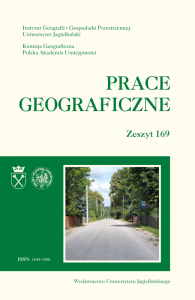Wpływ pokrycia terenu oraz jego zmian na rozmieszczenie stanowisk bobra europejskiego w Magurskim Parku Narodowym
The impact of land cover and its changes on European Beaver emplacement in the Magura National Park
Author(s): Piotr Szubert, Patryk WACŁAWCZYKSubject(s): Environmental Geography
Published by: Wydawnictwo Uniwersytetu Jagiellońskiego
Keywords: Carpathians; colonization; European Beaver; land abandonment; lodges; Magura National Park; reintroduction; secondary succession;
Summary/Abstract: Reintroduction of the European beaver (Castor fiber) in the Beskid Niski started in the 1980s. The increase in the beaver population coincided with the systemic, social and economic changes that took place both in the Beskid Niski and in the entire Poland. In the case of the Magurski National Park, they are part of a longer series of events of the twentieth century, related to intensive warfare and population exchange in this area. As a result, the structure of land use, as an effect of human impact on the natural environment, has undergone significant changes. The article attempts to assess the impact of changes in land cover on the European beaver population in Magura National Park. Particular attention was paid to the changes that take place in the immediate vicinity of the beaver sites. The intensity of land cover transformations within its impact zone was compared with changes that occur in other areas of the park, including those made by humans. The results of field surveys carried out in 1996, 2010 and 2021 were used in the research. Until 2019, information was obtained through segmentation and classification of orthophotos. The Mask R-CNN deep learning model and machine learning algorithms were used to extract information from cartographic materials. In the Magurski National Park area, from the 1980s to the present, there has been an increase in the number of beavers; the forest area and the density of buildings also increased, with a simultaneous decrease in the field and grassland area, as well as the density of the road network. During this period, beavers living in the study area showed a tendency to abandon their positions at the bottom of large river valleys near human habitations, in favour of inhabiting higher-lying areas, more distant from human activity zones. Currently, beavers inhabit the areas of abandoned Lemko villages and adjacent forests in the south of the national park. It is difficult to determine and requires further research whether the described change in the location of the beaver habitat results from the beaver’s desire to avoid humans or from other environmental conditions.
Journal: Prace Geograficzne
- Issue Year: 2022
- Issue No: 169
- Page Range: 43-68
- Page Count: 26
- Language: Polish

